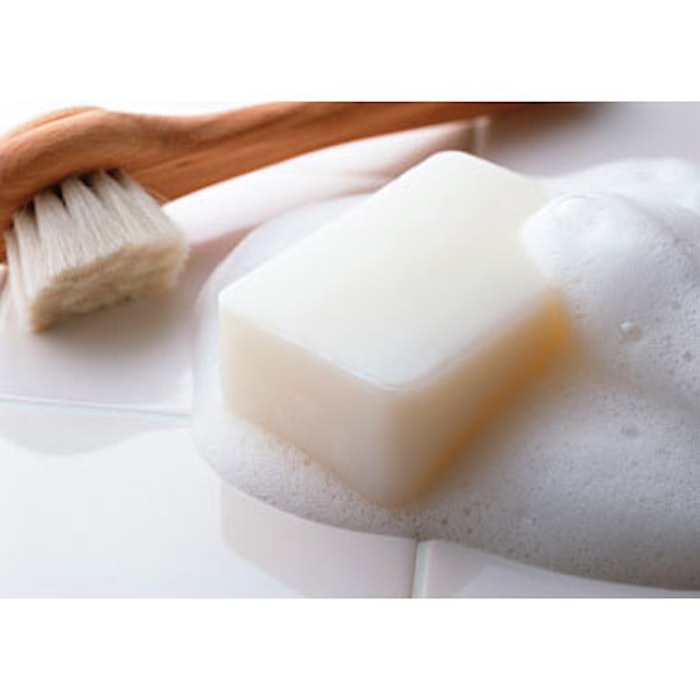
In the United States, cosmetics are regulated under the Federal Food, Drug, and Cosmetic Act (FFDCA). A cosmetic is defined as an article that is “intended to be rubbed, poured, sprinkled or sprayed on, introduced into, or otherwise applied to the human body ... for cleansing, beautifying, promoting attractiveness or altering the appearance.”
Traditionally, soap is not considered a cosmetic and therefore is not regulated. However, environmental and health concerns relating to the use of antibacterial ingredients and plastic microbeads in cleansers have spurred state action.
Soap vs. Cosmetic
A traditional soap without any detergents, moisturizers or abrasives is not considered a cosmetic, even though it is rubbed onto the body for cleansing. Traditional soap is made by boiling fats or oils with an alkali such as lye—the reaction product of fat or oil and alkali has to be the only cleansing agent in the final product, or it won’t be defined as a soap. In addition, the product has to be labeled and advertised as a cleanser only—it can’t be marketed as a moisturizer or deodorant.
Soaps that are made with detergents or chemicals that are antibacterial, abrasives or moisturizers are defined as cosmetics; and so are soaps that are advertised as making people smell better. In addition, some soaps are both cosmetics and drugs. Examples include: soap that is intended to kill bacteria, treat itching, act as a deodorant, relieve psoriasis or prevent acne. That’s because any article “intended for use in the diagnosis, cure, mitigation, treatment or prevention of disease” is defined as a drug under the FFDCA.
Over-the-counter drugs that can be bought without a prescription must have ingredients that are approved by the U.S. Food and Drug Administration (FDA). Soaps that are cosmetics and drugs have to follow the regulations for both categories of products. Antibacterial soaps are prime examples of products that are cosmetics because they are for cleansing—but not traditional soaps—and also drugs because they make claims to prevent the spread of disease.
FDA Action on Antibacterial Soaps
Last December, the FDA announced an investigation into antibacterial soaps. It said that millions of people use antibacterial soaps and body washes, but there is no evidence that these products are any more effective than regular soap and water.
In fact, daily use of antibacterial soaps may be harmful because it may lead to bacteria that resist antibiotics and create adverse hormonal effects. The FDA proposed a new rule that would require more data on the safety and effectiveness of antibacterial soaps. If they aren’t proven to be safe and more effective than regular soap and water, manufacturers will not be allowed to sell them. The proposed rule—or tentative final monograph—weighs the benefits of antibacterial soap against the risks of using it. It says that there are no antibacterial ingredients for soaps and body washes that are generally recognized as safe and effective. The rule would become effective one year after it’s finalized—if it is finalized in its current form.
In the 20 years since the FDA last thoroughly reviewed antibacterial ingredients, new information has been developed on their potential risks. Under the proposed rule, antibacterial ingredients in soaps and washes must be proven to be safe for long-term daily use. The studies that the FDA proposes include studies on the substances’ toxicology, whether they cause cancer, whether they affect hormones, and how they work.
Image copyright Getty Images
[pagebreak]
Of particular note, the FDA wants studies that will assess safety to pregnant women and children as they are among the groups of people who use antimicrobial soaps.
Another potential risk that has to be studied, according to the proposed rule, is the possibility of breeding antibiotic-resistant bacteria. The FDA says that “bacteria use some of the same resistance mechanisms against both antiseptics and antibiotics,” and as a result, the use of antibacterials could conceivably cause bacteria to resist antibiotics.
The FDA has already concluded that antibacterial soaps haven’t been proven to be better at reducing infections than plain soap and water. Manufacturers will have to show that their antibacterial soaps reduce infections before the antibacterial ingredients will be classified as generally recognized as effective.
Banning Triclosan
Triclosan and triclocarban are the most frequently used antibacterial additives in soaps and body washes, although there are many chemicals that can kill bacteria or viruses. Triclosan, in particular, has become a target for state regulation, in part because the FDA first proposed banning its use in some consumer products 35 years ago and just proposed action last December. It will take several years before the FDA’s new proposed rule on all antibacterial soaps comes into effect.
As the federal government tends to move slowly, state governments often take action when it comes to safety regulations and a perceived consumer threat. Minnesota’s ban on triclosan fits right into the consumer perception-based movement. Effective January 1, 2017, no cleaning products used by consumers and containing triclosan may be offered for retail sale in the state unless the FDA has approved them for consumer use.
Minnesota doesn’t have any safety or efficacy data that isn’t available to the FDA, and so its new law is based on a fundamental shift in how legislators view risks. Instead of the traditional regulatory view that chemicals can be used until they are proven unsafe, laws such as Minnesota’s assume that everything is unsafe until proven otherwise.
Iowa and New York have similar bills pending: Iowa’s bill would prohibit triclosan in soap, hand sanitizer and toothpaste starting in 2015. Manufacturers who replace triclosan will be required to use the least toxic alternative in their products, but the bill is silent about effectiveness. New York’s bill would ban selling or offering for sale any soap or cleaning product containing triclosan or triclocarban.
Many manufacturers have already committed to phasing out triclosan. Avon will not use triclosan in new products and is phasing it out in existing products. According to Jennifer Vargas, Avon’s director of corporate communications, that decision was based on the preferences of Avon representatives and their customers. Johnson & Johnson says on its website that it will phase out triclosan by 2015; and Procter & Gamble says it will phase out triclosan in 2014, although both say they are acting in response to consumer demand and not because of risks to consumers.
Recent Moves to Ban Microbeads
Some soaps and washes use plastic microbeads as gentle exfoliants. Plastic microbeads may absorb environmental toxins and then accumulate in waterways where animals eat them, perhaps because they look like fish eggs. Microbead pollution has been detected in the Great Lakes, and neighboring states have taken the first actions to ban them. This issue has gained immediate traction, and state legislative responses are being proposed and moved quickly. A federal bill to ban microbeads was introduced in June but has almost no chance of passing, and so once again state governments are filling the void left by federal inaction.
Image copyright Getty Images
[pagebreak]
An Illinois bill was signed into law by Governor Pat Quinn in June. It bans manufacturing any personal-care products with synthetic plastic microbeads as of December 31, 2017. No person can accept personal-care products for sale as of December 31, 2018, if they contain microbeads. Over-the-counter drugs with microbeads—such as soaps that are sold with claims for treating or mitigating skin diseases—can be made and sold for one year more than non-drug microbead products. Penalties are $1,000 per day for a first violation and $2,500 for subsequent violations.
A bill in New York would prohibit selling any cosmetic product containing plastic microbeads. First-time violators in New York would face a penalty of $2,500 per day, and second-time violators would face penalties of $5,000 per day. If passed, the bill will take effect January 1, 2016.
In addition to the activities banned in Illinois, similar legislation in Michigan also singles out cosmetics containing microbeads for its proposed ban. Violators would be fined $1,000 per day.
Ohio has a proposed bill that would prohibit selling or offering for sale any cosmetic or personal-care product with microbeads, and two Wisconsin legislators are reportedly planning to introduce bills next January to ban microbeads. Minnesota has proposed a bill banning the sale of most products containing microbeads after July 1, 2015, and will study the effects of microbeads in state waters, and on ecosystems and human health.
Other states besides those in the Great Lakes area are also considering microbead bans. California’s State Assembly passed a bill that would outlaw offering or selling personal-care products with plastic microbeads by 2019, and personal-care products that are also over-the-counter drugs by 2020, but the bill did not pass the Senate. The bill’s author Democratic Assemblyman Richard Bloom has vowed to re-introduce the proposed legislation. If passed, violators could be fined up to $2,500 per day. Additionally, the state attorney general, district attorneys, city prosecutors and city attorneys in larger cities will be able to sue to enforce the law and keep any penalties they collect, creating a means to self-fund enforcement.
New Jersey introduced a bill in May to ban the manufacturing of cosmetics with microbeads as of January 1, 2015, and would ban selling or offering cosmetics with microbeads within two years after enactment of the law or January 1, 2018, whichever is sooner. Penalties are between $1,000 and $10,000 per day.
Avon, Unilever, Johnson & Johnson, L’Oréal and other companies have agreed to phase out microbeads. Most companies are not committing to a specific timetable, because more research is required to develop substitutes that are safe for humans and the environment.
A Patchwork of State Laws
When consumers perceive that the federal government is not adequately protecting them or the environment, they naturally turn to their state legislature for remedies. Often, states can be more innovative and act much faster than the federal government.
However, in the field of product regulation when two or three states ban a product or an ingredient, that effectively bans the product nationwide, because it is often impractical for manufacturers to keep products out of a few states. And—as the proposed triclosan bills make clear—states usually pass slightly different versions of the same basic concepts, with different effective dates. The result is a checkerboard of different regulations in different states, with industry having to comply with the most restrictive elements in each state’s legislation or else have a product that can’t be distributed nationwide.
Image copyright Getty Images
[pagebreak]
When and how to permit states to impose their own regulations on national products is often a focus of legislative reform efforts, with industry advocating strong federal laws that prohibit inconsistent state action. The FDA and cosmetics industry trade associations had been working together on reforming U.S. cosmetics laws, agreeing to a framework that included limiting states’ abilities to regulate cosmetics. The FDA pulled out of the discussions in March, asserting that the industry’s proposed legislation “actually prevents federal and state governments from protecting Americans from unsafe cosmetics.” The Professional Beauty Association and the Independent Cosmetic Manufacturers and Distributors countered that the FDA letter mischaracterized the industry’s position.
Soaps and other personal-care products with triclosan and microbeads will likely continue to be a focus of significant regulatory effort as more states pursue regulatory action.
Jean Warshaw is a lawyer in private practice in New York City. She provides advice on business and environmental law. She can be reached at 212.722.2240.
Image copyright Getty Images











